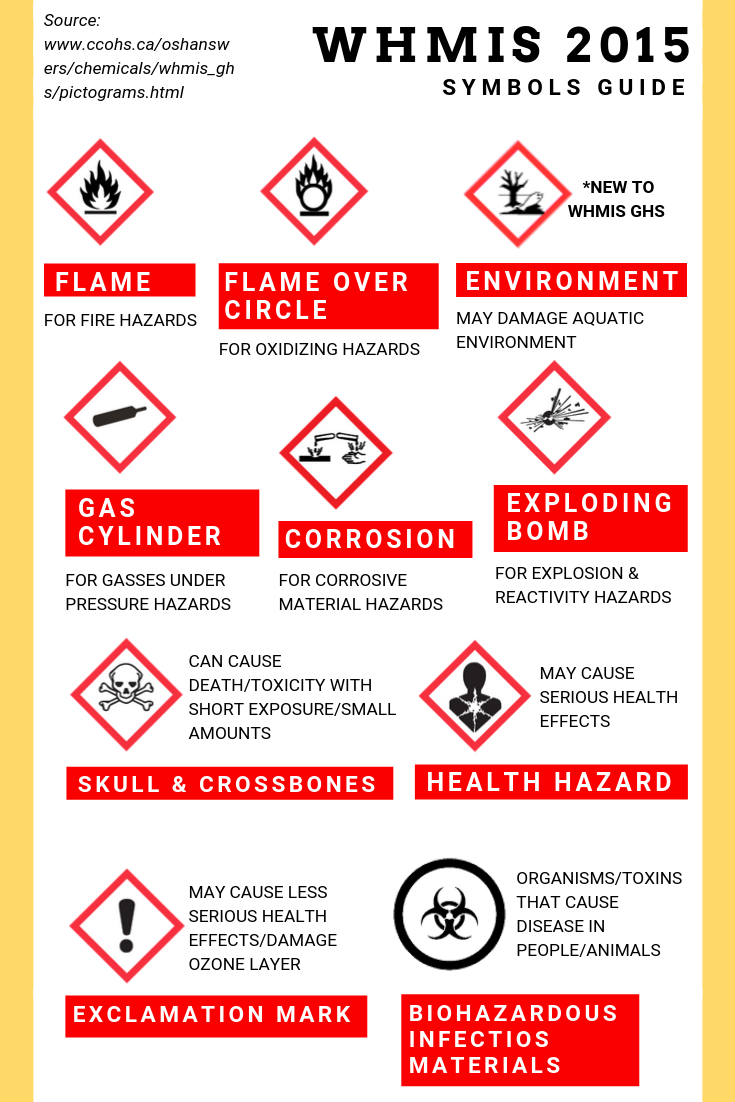Today we are going to give you a thorough breakdown of WHMIS symbols 2021.
Acute has over 100 years of combined experience with in-house or on-site worker environmental and safety training. We want to help you get the training you need to keep your workers safe.
WHMIS is a comprehensive system for providing health and safety information on hazardous products intended for use, handling, or storage in Canadian workplaces. We’ll take a look at the changes made to the WHMIS symbols in 2015 and what these mean for you and your workplace. So, let’s get going.
Your Updated Guide To WHMIS Symbols 2021
WHMIS Aligned with GHS:
In 2015, the Canadian Center for Occupational Health and Safety aligned the Workplace Hazardous Materials Information System (WHMIS) with the Globally Harmonized System of Classification and Labelling of Chemicals (GHS).
This alignment resulted in significant updates with respect to WHMIS symbols.
WHMIS 1988 (the original version) was phased out in December 2018.
WHMIS Symbols 2021:
WHMIS symbols are presented in the form of pictograms, defined as “graphic images that immediately show the user of a hazardous product what type of hazard is present.”
Our infographic will help you recognize the different WHMIS symbols, what they are called, and what they mean.
Download Infographic:
Feel free to download the infographic and print it off to help you study for any upcoming WHMIS training you may have!

What Is WHMIS?
Workplace Hazardous Materials Information System, more commonly referred to as WHMIS, is a comprehensive system for providing health and safety information. The system applies to hazardous products found in Canadian workplaces that are:
- Used
- Handled
- Stored
In 2015 WHMIS aligned with the Globally Harmonized System of Classification and Labelling of Chemicals, known as GHS.
Benefits of WHMIS and GHS
The GHS is a worldwide hazard communication system, so aligning WHMIS with GHS has many great benefits, including:
- Hazard classification criteria has become more comprehensive which greatly improves the ability to point out the severity of hazards
- New hazard classes have not been included in WHMIS
- Physical hazard criteria are now consistent with the Transport of Dangerous Goods (TDG regulations)
- There is a standardized language for hazard and precautionary statements
- There is now a standardized SDS format plus more comprehensive requirements

WHMIS is a comprehensive system that provides you with health and safety information in the workplace
Who Needs WHMIS Training?
Workers are required to complete WHMIS training when necessary. When starting a new job, many workplaces require new workers to complete a WHMIS training course. WHMIS training is required if you:
- May be exposed to chemicals or a hazardous product during work activities (this includes normal use, maintenance and emergencies)
- Use, store, handle or dispose of hazardous products and materials
- You supervise workers who may be exposed to, use, store, handle or dispose of hazardous products
- Work in emergency response
If you are working in an Ontario workplace, chances are you will need to complete WHMIS training.
What Industries Require WHMIS Training?
Some of the most common industries that will require you to take WHMIS training include:
- Retailers
- Restaurant Employees
- Medical Professionals
- Construction Workers
- Factory Workers
- and more!
The list above is not exhaustive – remember that WHMIS training is mandatory for any workers who work with or who may be potentially exposed to hazardous products in the workplace.

WHMIS Symbols 2021: Many different industries will require you to take this training
WHMIS Requirements
In Ontario, there are two requirements for WHMIS. According to Ontario.ca, The WHMIS requirements are:
“1. The Occupational Health and Safety Act (OHSA) generally requires employers to ensure hazardous products are identified, to obtain safety data sheets and make them available in the workplace and to provide instruction and training to workers. The OHSA also provides for the protection of confidential business information according to procedures set out in the federal HMIRA.”
“2. The Workplace Hazardous Materials Information System Regulation (R.R.O. 1990, Regulation 860) sets out in detail the employer’s duties respecting labels and safety data sheets for hazardous products and prescribes the content and delivery of worker education programs. The regulation also sets out the types of confidential business information the employer may withhold from a label or safety data sheet.”
Additional Health and Safety Protection
WHMIS training helps you recognize and avoid potential health and safety risks. If your job requires you to wear a respirator, then taking respiratory protection training and getting your respirator fit tested is a great idea. This training program will teach you the legal and practical requirements for the use of respiratory protective equipment in the industrial and agricultural workplace. The program includes a review of various types of respiratory protective systems as well.
WHMIS Training Resources
Are you getting ready to complete WHMIS training? Becoming familiar and comfortable with WHMIS pictograms is one of the best ways to prepare for WHMIS training courses and tests. Here, we’ve compiled a listing of resources for you to use and help you prepare:
– CCOHS – WHMIS 2015 – Pictograms
– WHMIS Test: Fact or Fiction
– WHMIS Test Answers & Hints
– Ontario.ca – WHMIS
– University of Waterloo – Transitioning from WHMIS 1988 to WHMIS 2015
– WHMIS.ca – About GHS
– Study.com – Practice WHMIS Test

WHMIS Symbols 2021: You will need to be familiar with these symbols in most workplaces
WHMIS 2015 (GHS) Training Course – Learn More
Who should enroll in the WHMIS training program?
WHMIS training is mandatory for any worker who works with or is potentially exposed to hazardous products in the workplace. This training program will also be of interest to new hires, Joint Health and Safety Committee members and any worker who wishes to have a deeper understanding of the new provisions of the Globally Harmonized System as well as the requirements mandated by the province’s WHMIS legislation.
Training program topics include:
- Responsibilities of employers, supervisors, workers and suppliers
- Recognizing, assessing, controlling risks as well as evaluating the effectiveness of controls
- Understand labels – WHMIS 2015 (GHS)
- Recognize the WHMIS 2015 (GHS) pictograms (symbols) and understand the hazards that they represent
- Identify the hazards represented by each hazard class
- Understand the significance of signal words – WHMIS 2015
- Find additional information about hazards and protective measures on [material] safety data sheets ([M]SDSs)
- WHMIS 2015 differences:
- New rules for classifying hazardous workplace chemicals
- Two main hazard classes – physical hazards and health hazards
- New label requirements, including pictograms instead of symbols that correspond to hazard classes
- A different format for safety data sheets
Program Content
Program content has been designed to provide workers, supervisors and employers relevant information under WHMIS 2015 (GHS) about the safe handling, use and storage of hazardous materials in the workplace. Specific workplace examples are used wherever possible to enhance the relevance of the course for participants…[Learn More]
Course Duration: 2 hours

WHMIS Symbols 2021: WHMIS training will help you identify various hazards represented by each hazard class
You May Also Need HAZWOPER Training
HAZWOPER stands for Hazardous Waste Operations and Emergency Response. HAZWOPER training is important for anyone who is exposed to hazardous substances and who is engaged in operations including clean-up, treatment, storage, and disposal of hazardous waste.
Workers involved in an emergency response operation dealing with hazardous waste, and workers who have to perform duties at a waste site where hazardous materials or contamination exist should be fully trained and protected.
Learn more about ACUTE’s HAZWOPER training
Training With ACUTE
With over 100 years of combined experience, you can be sure to receive quality, hands-on training from knowledgeable and experienced staff. Here are some of the differences when training with ACUTE:
- Open Door Instructor-Student Partnership – ACUTE’s training services emphasize client participation. Our staff
 want to build a relationship with clients and serve as a touchstone for advice anytime moving forward.
want to build a relationship with clients and serve as a touchstone for advice anytime moving forward. - Serving Your Team and Industry – With a vast array of clients in the manufacturing, construction, health, academic, and government sectors, ACUTE brings the best safety practices from across the spectrum to your workplace.
- 100 Years Combined Experience – ACUTE provides comprehensive health and safety training, on-site safety services, and consulting services. With over 100 years of combined experience, our company staff offer more than theoretical or abstract ideas. ACUTE offers solutions.
- Track Record of Success – ACUTE is rated 4.9/5 stars on Google reviews, demonstrating a commitment to our clients, quality, and passion for training.
What Our Customers Are Saying…
“ACUTE’s trainers have a passion for the material and care about their clients.”
– Rob, Tank Manufacturing Company
ACUTE is located in Waterloo, Ontario, and services customers from the cities such as Toronto, Mississauga, Brampton, Hamilton, Milton, Kitchener, London, and Guelph, as well as other cities from across Ontario.
Sources:
https://www.workplacesafetynorth.ca/print/2268
http://www.ccohs.ca/oshanswers/chemicals/whmis_ghs/general.html



